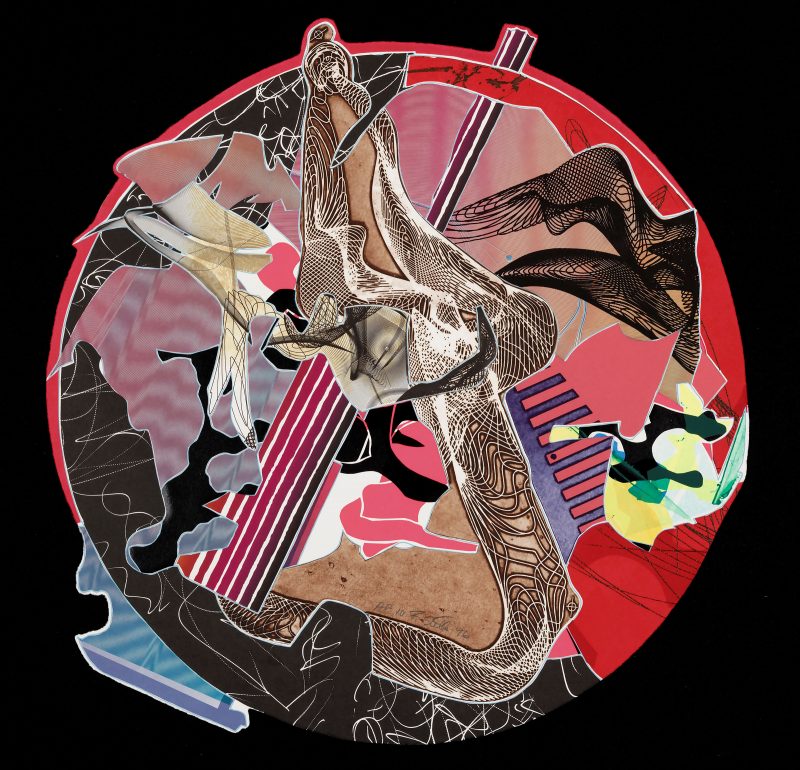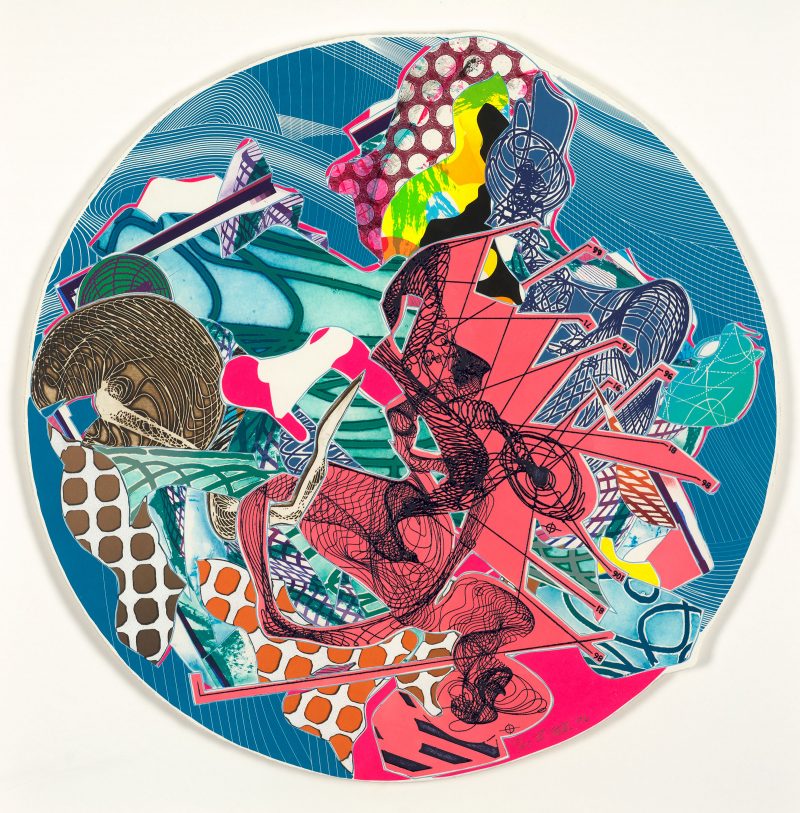We misinterpreted the title Frank Stella: Unbound. One of us thought it meant everything Stella has ever attempted, a wilder new Frank Stella Retrospective. The other, attuned to the world of LGBTQ, thought it referred to a stage in a woman’s transition to a man. There are books and articles galore titled Unbound. It’s a contemporary buzzword. But neither the coddled curators of Princeton nor the rich but incurious Frank Stella do much actual thinking. They’re just doing what most people do most days. They’re going through the motion.
What does Unbound mean? It means these collages are literary, as if they were pages from books. Stella borrowed ideas from Moby Dick, from the Passover song Had Gadya, from a compilation of folktales, and from the illustrated The Dictionary of Imaginary Places.
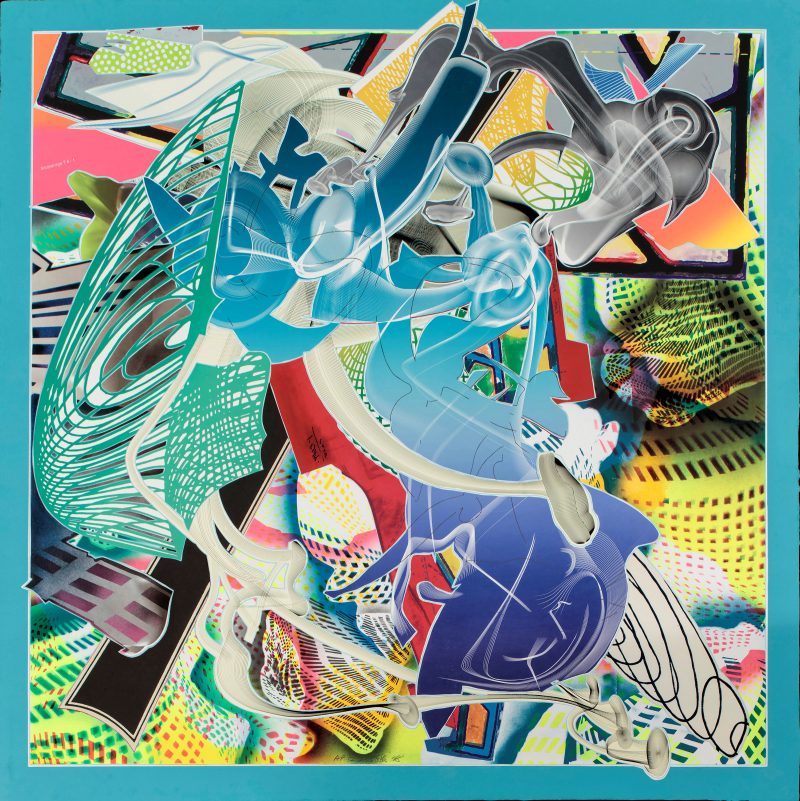
Here’s what critics said at the time these prints debuted.
“What interests me is the intensity of a personality, transposed directly and clearly into the work, man and his vitality.”
– Tristan Tzara
“The function of the work, with many different levels of connotation-content unbounded rather than definite, and open to successive discovery rather than apprehended in a single moment of divination.”
– Meyer Schapiro
Do Frank Stella’s collages achieve coherency and can coherency be a detriment to making daring art? Did Stella once make daring art but does so no longer?
Inconsistencies can bring about new developments and by violating present canons create alternative impressions. What about the anti-aesthetic? Stella creates beautiful art, but is it at the expense of breaking taboos, as the Dadaists did? Yes, his abstract collages are pleasing to the eye, ingratiating in their use of color. But are they dull, or interesting and full of surprises, as say, John Ashbery’s poem “Le Livre est sur la table”?
“The young man places a bird-house
Against the blue sea. He walks away
And it remains. Now other
Men appear, but they live in boxes.
The sea protects them like a wall
The gods worship a line-drawing
Of a woman, in the shadow of the sea
Which goes on writing.”
Ashbery is the pre-eminent literary art critic of the last fifty years.
In this poem, there is evidence of observable inconsistency and non-sequitur, but, whereas we are in the habit of seeing something astonishing in Ashbery, is the astonishing evident in Stella’s print collages as well? Or is he merely repeating himself in less audacious work?
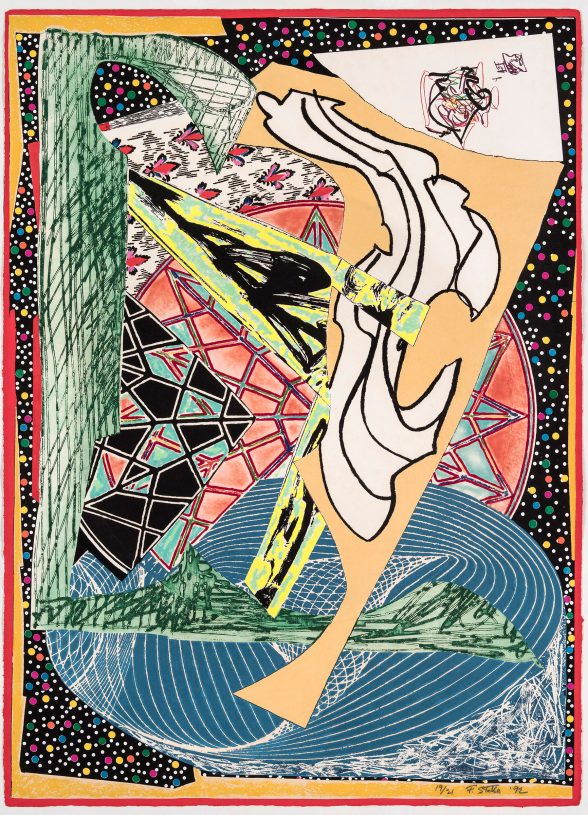
Questions about coherence and completeness
In Frank Stella’s current show coherence can be found, but does it move us, and is he adhering to norms of style which can inhibit rather than defy established conventions?
In judging an artist’s greatness it is not necessary for the work to be consistent in style or complete. Inconsistencies can be evidence of the most daring art and can be found in the works of Michelangelo, Dostoevsky, Kandinsky and Picasso, who are among our greatest artists.
Therefore, is Stella too perfect? Is his work static or does it advance, as the land might, in Ashbery’s poem, or in Kandinsky, where the viewer can distinguish, along models of chaos, an incoherent work and its incompleteness. Or in Ashbery, where he makes a disjointed radical break with the expected tradition and makes readers experience the poem, and thereby the world, as chaotic and incomplete.
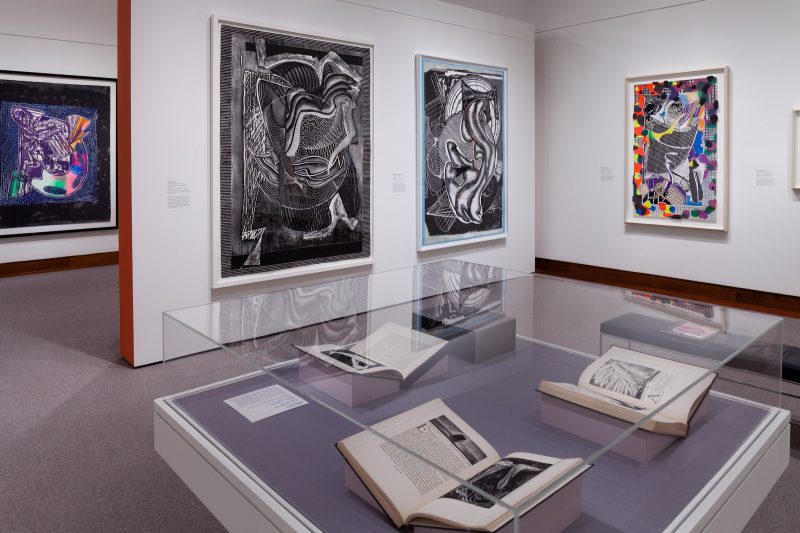
Meaning and the eye of the beholder, the eye of the scholar, the eye of the artist
Stella suggests that the collages are to be considered as forms of representation and not to be taken literally. However, connecting to Stella’s collages requires the viewer to have knowledge of the literary work to “get it,” which can make appreciation limited. Or do we pretend to grasp but not really grasp? Or does the work open up a field of vision in which we can subjectively interpret various meanings. This uncertainty makes the artist’s work difficult to know fully, though we can embrace general realms of connotation and make connections from our subjective experience.
However, has Stella failed to achieve his purpose as we are either moved or unmoved? This depends on your estimate of his creative powers. Therefore, we contemplate Stella with delight, dismay, frustration, or disappointment depending on how we interpret meaning, that is inaccessible to all but scholars, and sometimes not even then, since these works are products of Stella’s subjective imagination.
Aesthetics and values of the art world, subversive art, and the role of the critic
Interpretation of the work will also depend on your worldview, culture and psychological makeup. This leads us to examine the aesthetics and values of the art world of 1988 and thereafter, and the corruption of the art market, a time when patronage of the arts was controlled by powerful corporations, government and academic institutions, none of which were concerned with supporting subversive art.
Have market and institutional factors caused artists like Stella and others to make aesthetic decisions based on the prevailing sanctions at the time, rather than charting new territory with more edgy risk-taking art? This situation is still present and seen in the canons of materialism and respectability that have undermined so much of our art.
Therefore, serious art criticism of contemporary art is needed more than ever, to counteract these dominant forces, which, rather than supporting art and artists with funding and museum exhibitions, are undermining breaking taboos and the creation of art that is more varied and critical of the society, the corporation, conformity, rigidity-all that is destroying our artistic expression.
Stella is an abstract artist who has a secure place in art history as a once-influential, now overpriced figure, considered dated and minor, by some. Attempts to connect his hard-edged abstractions to life have had few successes. Stella was married to the art critic Barbara Rose. He has literary friends, such as the poet, novelist and editor, Jill Hoffman. But Stella is no star. He ranks himself with Warhol and Dylan. But he is his own stele, a marker of an era.
Dorothy Friedman August is an award winning poet and has published poetry, art and film reviews. She has published two books of poetry and her work has appeared in The Partisan Review and other journals. She has been teaching writing and literature at Fordham University and Empire State College.
Michael Andre is a Canadian poet living in Princeton. He has published hundred of art reviews in Art News, Art in America, Village Voice, Artblog. In fact he has published close to a thousand reviews, but that may be too many. He’s afraid to count.
Frank Stella Unbound: Literature and Printmaking, Princeton University Art Museum in Princeton, NJ is currently on view until Sunday, September 23, 2018.


